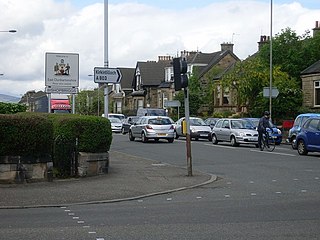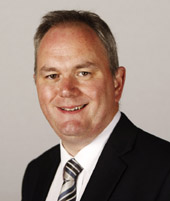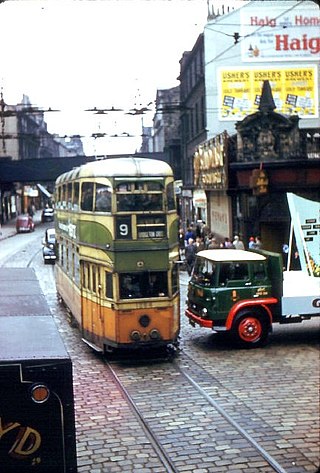
Lanarkshire, also called the County of Lanark, is a historic county, lieutenancy area and registration county in the Central Lowlands of Scotland. The county is no longer used for local government purposes, but gives its name to the two modern council areas of North Lanarkshire and South Lanarkshire.

Robroyston is a suburb of Glasgow, Scotland, located around 3 miles (5 km) north-east of the city centre.

Glasgow North East is a burgh constituency of the House of Commons of the Parliament of the United Kingdom. It was first contested at the 2005 general election. The current Member of Parliament (MP) is Anne McLaughlin of the SNP. McLaughlin herself previously represented the seat from 2015-17, when she lost the seat to Labour, but regained the seat at the 2019 general election and has represented the constituency ever since.
Glasgow Springburn was a constituency of the House of Commons of the Parliament of the United Kingdom from 1918 until the 2005 general election, when it was largely replaced by the Glasgow North East constituency.

Springburn is an inner-city district in the north of the Scottish city of Glasgow, made up of generally working-class households.

Balornock is a district in the city of Glasgow, Scotland. Situated outside the city centre, north of the River Clyde, it forms part of the larger area of Springburn.

Colston is a mostly residential area in the Scottish city of Glasgow; situated on the northern edge of the city, it is surrounded by the Glasgow areas of Milton to the west and Springburn to the east, and the town of Bishopbriggs to the north. The main road through Colston is the A803, which then becomes Kirkintilloch Road once past Colston to the north through Bishopbriggs.

Cowlairs is an area in the Scottish city of Glasgow, part of the wider Springburn district of the city. It is situated north of the River Clyde, between central Springburn to the east and Possilpark to the west.

Hogganfield is a district in the Scottish city of Glasgow, located to the north east of the city centre. Hogganfield is surrounded by the Glasgow districts of Blackhill, Craigend, Millerston, Provanmill, Riddrie, Robroyston, Ruchazie and Stepps. The M80, Stepps bypass, separates Hogganfield from Robroyston.

Paul Martin is a Scottish politician who served as Member of the Scottish Parliament (MSP) for the Glasgow Provan constituency from 2011 to 2016. A member of the Scottish Labour Party, he previously represented Glasgow Springburn from 1999 to 2011.
Blackhill is an area of north east Glasgow, Scotland. It is directly bordered by the M80 motorway to the west and the M8 motorway to the south. The neighbourhood falls within the North East ward under Glasgow City Council.

Stobhill Hospital is located in Springburn in the north of Glasgow, Scotland. It serves the population of North Glasgow and part of East Dunbartonshire. It is managed by NHS Greater Glasgow and Clyde.

All Saints Roman Catholic Secondary School is a comprehensive, co-educational, Roman Catholic state school situated in Barmulloch the north-east of Glasgow, Scotland. Established in 1972, the school was rebuilt into a newer, more modern version in 2002, with better facilities but fewer classrooms. The headteacher is Brian McDermott.

Glasgow Corporation Tramways were formerly one of the largest urban tramway systems in Europe. Over 1000 municipally-owned trams served the city of Glasgow, Scotland, with over 100 route miles by 1922. The system closed in 1962 and was the last city tramway in Great Britain.

The Glasgow trolleybus system operated in and immediately surrounding the city of Glasgow, Scotland, between 1949 and 1967, with the network reaching its largest extent in 1959. It was the only British system to open after World War II.

Glasgow, the largest city in Scotland, has several distinct styles of residential buildings. Building styles reflect historical trends, such as rapid population growth in the 18th and 19th centuries, deindustrialization and growing poverty in the late 20th century, and civic rebound in the 21st century.
The Switchback was a railway line in the East End of Glasgow, Scotland, constructed by the Caledonian Railway (CR). Connecting the lines at Rutherglen on the south side of the city with Robroyston on the north side, this route also served a number of industrial sidings and rail yards.

Springburn/Robroyston is one of the 23 wards of Glasgow City Council. Created as Springburn, in 2007 and in 2012 it returned three council members, using the single transferable vote system. For the 2017 Glasgow City Council election, the boundaries were changed, the ward increased in size and population, was renamed Springburn/Robroyston and returned four members.

North East is one of the 23 wards of Glasgow City Council. On its creation in 2007 and in 2012 it returned four council members, using the single transferable vote system. For the 2017 Glasgow City Council election, the ward boundaries were redrawn with a smaller size and population, and it returned three members.
















